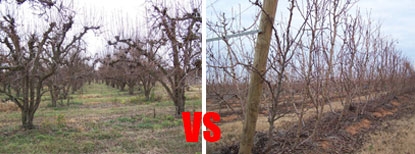It is possible to increase yields of close-planted Williams pear trees by changing the way you manage trees, not by changing the rootstock.
Fruit set of Williams’ Bon Chretien (Williams) has been well documented. For instance it is known that Williams is variably parthenocarpic—which means it sets fruit without pollination—and that pears grow to full size without fertilisation. It is also known that the rate of parthenocarpic fruit set is genetically determined among pear varieties, but is greatly affected by the environment.
In Australia, Williams flowers were believed to set fruit by vegetative pathenocarpy, and fruit grew without any exogenous stimulant such as pollination or plant growth regulator.
However, trees often took 7 to 9 years before enough fruit could be harvested, and free-standing trees took at least 17 years to settle down to a modest 40 to 45 tonnes per hectare. This was because trees were planted at low density (278–330 trees per hectare), the seedling rootstock Pyrus calleryana D6 was used, and because young trees were pruned hard with many heading cuts made in winter—which resulted in mature trees becoming ‘over-limbed’ and ‘over-shaded’.
Pollination research
Most research on pollination and fruit set of Williams showed that cross-pollination increased fruit set compared with that of self-pollination.
Cross-pollination often led to fertilisation but fruit remained seedless when ripe because the seeds did not mature, but left small seed-like structures (integuments).
The hormones auxin and gibberellins are produced in seeds in most fruit, and are also produced in high enough concentrations in the fruitlet’s pericarp to induce fruit set and maintain fruit growth.
Seedling rootstock blamed for poor tree performance
Although we know a lot about the Williams pear, most orchardists, especially in Australia, have been concerned that trees take a long time to come into production, and that yields of mature trees are relatively low and fruit is of poor quality.
The use of a vigorous seedling rootstock was often blamed for the poor performance. No wonder much of the research was, and still is, focussed on finding the perfect size-controlling rootstock.
Many believe that the performance of Williams could only improve if trees are planted at high-density and on a size-controlling rootstock. Finding, therefore, the equivalent of the M9 apple rootstock has been, and still is, the Holy Grail of a hardy, size-controlling, precocious rootstock.
The pursuit of producing such a rootstock has been going on unabated for more than 60 years. Some may argue that progress has been made.
Pollinisers, beehives and RDI
When it became known that cross-pollination enhanced fruit set of Williams, orchardists in Australia began to interplant Beurre Bosc (Bosc), which flowered with Williams.
However, copper sprays were usually needed to make the skin of the Bosc brown (russet), while Williams pears had to remain russet-free.
Packham’s Triumph (Packham) trees were sometimes interplanted with Williams trees, but Packham was a poor polliniser because it flowered earlier than Williams.
It was later discovered that the nashi (Asian pear) variety Nijisseiki was a much better polliniser, because it started to flower just before Williams did, was very precocious, spurry and compact, and bees liked the nectar.
Interplanting + bee hives=increased yields
Orchardists who interplanted their old free-standing Williams with Nijisseiki and introduced beehives, saw that yield increased.
Regulated deficit irrigation reduced vigour
Regulated deficit irrigation (RDI) helped to reduce excessive vigour, but the peculiar fruiting habit of Williams made it difficult to match the production of other spur-type pear varieties.
High density planting
Pyrus calleryana D6 has been widely adopted in Australia since the 1950s.
It is hardy for arid Australia, compatible with all European pear varieties, easily propagated (from seed), and the scion can be made precocious if well managed.
It was not until Williams trees on Pyrus calleryana D6 rootstock were planted closely and trellised, nashi pollinisers were interplanted, beehives were introduced, RDI, drip irrigation and Ethrel were used to control shoot growth, that precocity improved and trees could be brought into full production by year six (see Tree Fruit November 2003, September 2004, May and June/July 2007).
How we achieved the highest production efficiency ever (continued next month)
See this article in Tree Fruit July 2015






















